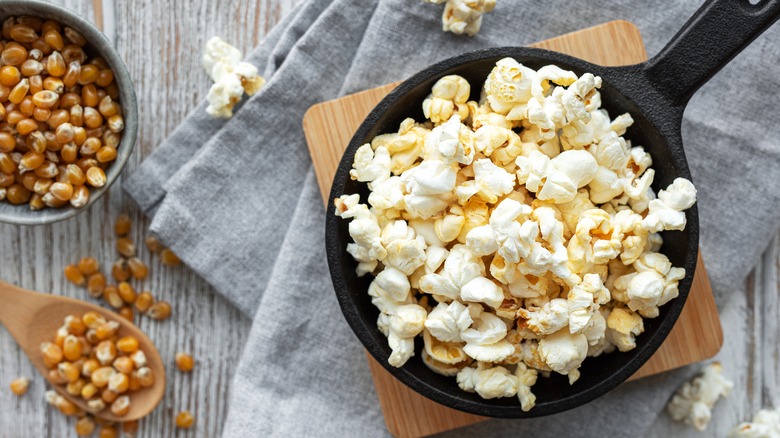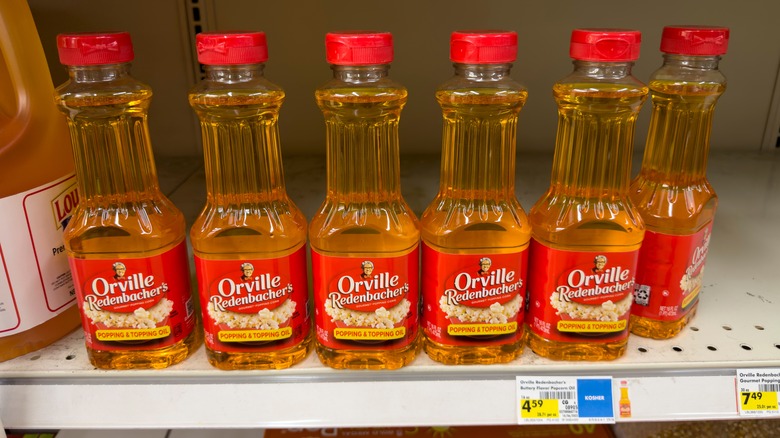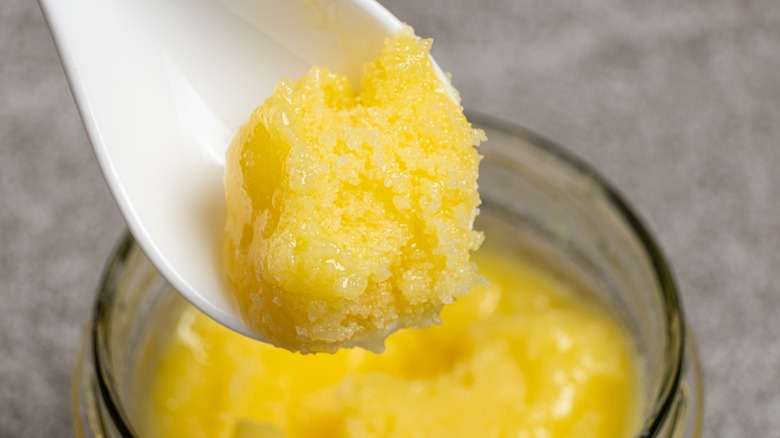The Oil Mistake You're Making When Popping Popcorn
We may receive a commission on purchases made from links.
A tub of rich, buttery bliss from the concession stand is almost as enticing as seeing the next blockbuster, but when some try to recreate the experience on movie night at home, they make the mistake of using the wrong kind of oil. They end up with a lackluster flavor, or worse, a slightly burnt essence clinging to what could have been little fluffy kernels bursting with buttery goodness.
People sometimes mistakenly think that movie theaters use real butter to flavor their trademark concession product, but this isn't generally the case. Many use a blended substitute made with soybean and canola, and the rich taste typically comes from diacetyl — an ingredient found naturally in butter. The combination of high smoke point oils and the flavoring agent create the signature aroma that keeps folks coming back to the snack bar.
When making popcorn at home, starting with the right type of oil is the key to creating a light, fluffy snack that most closely resembles what you would get at the cinema. The kernels used to start the process require a temperature of about 356 degrees Fahrenheit to pop. If you use something with a lower smoke point, it will likely leave a burnt taste on the end product. But infused popcorn oils have a high-smoke point, and impart that enticing butter flavor people look forward to.
Flavored oils make popcorn like the movie theater
Making popcorn from kernels is the only way to go for an authentic movie theater experience at home. You can use the microwave or the stovetop, but with either method, using a flavor-infused oil will get you the best results for taste. Brands like Orville Redenbacher's and Snappy Butter Burst are specifically designed for making popcorn, and a variety of oils can be found in most grocery stores or online.
Some assume you can use butter instead of oil, but that's one of the mistakes when popping popcorn you want to avoid. Butter has a smoke point of about 300 degrees, which means it will start to burn before your kernels ever get a chance to transform into the light, crunchy snack you are trying to achieve. As good as corn on the cob is with butter, the effect just won't be what you intended for popcorn. Many other oils aren't really appropriate either; beyond being an offbeat choice of flavor for popcorn, extra virgin olive oil doesn't appreciate getting to such high temps. Canola is perfect because it won't burn, having a smoke point of around 400 degrees.
If you forgot to grab some popcorn oil on your last trip to the supermarket, there are substitutes you can use that are likely sitting right in your pantry. However, they don't impart an abundance of flavor to the snack. They will give the popcorn a mild nutty aroma, but if you want a wallop of flavor in every bite, you'll want to introduce some fats.
Avoid the mistake of only using oil
Some prefer to avoid using high-fat content additives when making a bowl of popcorn, and for these folks, cooking it solely in canola or avocado oil is all that is needed. Those less concerned about using fatty additions have a few different options for elevating their popcorn to a movie theater-caliber snack. Duck fat is one ingredient that can be mixed with your oil to impart a savory, buttery flavor to the dish, and its high-smoke point will allow it to remain unburnt while the kernels pop.
You can also toss fats into the mix after the kernels have cooked. Ghee and clarified butter are fan favorites when it comes to making movie theater-style popcorn because they both possess a natural butter flavor that closely resembles the flavored oils theaters use to make their concession snack. After all your kernels have fluffed up, add a little bit of either one of these ingredients and toss the popcorn in the bowl to distribute it evenly throughout the dish.
Continue adding a little at a time (it would be a horrible mistake to saturate the popped kernels and make them soggy) until you achieve the buttery consistency you're looking for. Add a bit of salt immediately after adding the fats as the chef's kiss and sit down to enjoy the latest movie addition to your streaming platform with a bowl of popcorn that tastes like you bought it at the concession stand.


